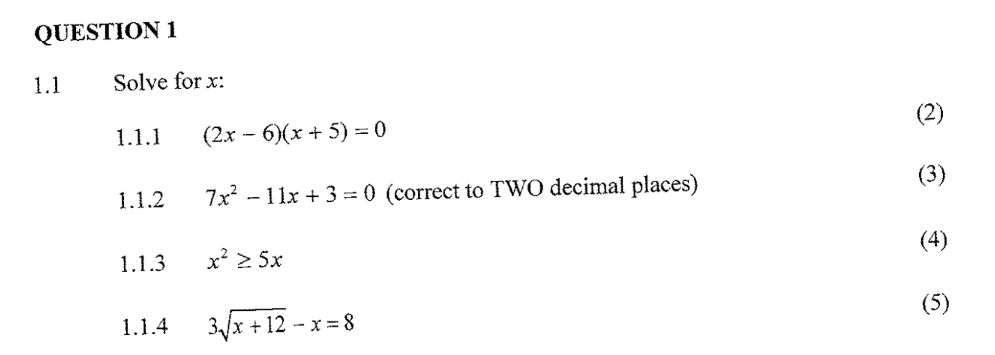Solve for x: (2x - 6)(x + 5) = 0; 7x^2 - 11x + 3 = 0 (correct to TWO decimal places); x^2 ≥ 5x; 3√(x + 12) - x = 8.

Understand the Problem
The question is asking for solutions to a set of equations in the variable x. Each part requires solving a different type of equation. The goal is to find the values of x that satisfy each equation or inequality provided.
Answer
1. $x = 3, -5$ 2. $x \approx 1.23, 0.35$ 3. $x \in (-\infty, 0] \cup [5, \infty)$ 4. $x = 4$
Answer for screen readers
The solutions are:
- $x = 3, -5$
- $x \approx 1.23, 0.35$
- $x \in (-\infty, 0] \cup [5, \infty)$
- $x = 4$
Steps to Solve
- Solve the first equation: $(2x - 6)(x + 5) = 0$
This equation is set to zero, so we can use the Zero Product Property. Set each factor to zero:
$$ 2x - 6 = 0 $$ and $$ x + 5 = 0 $$
Solving these gives:
$$ 2x = 6 \implies x = 3 $$
and
$$ x = -5 $$
The solutions are $x = 3$ and $x = -5$.
- Solve the second equation: $7x^2 - 11x + 3 = 0$
To solve this quadratic equation, we can use the quadratic formula:
$$ x = \frac{-b \pm \sqrt{b^2 - 4ac}}{2a} $$
where $a = 7$, $b = -11$, and $c = 3$.
Calculating the discriminant:
$$ b^2 - 4ac = (-11)^2 - 4(7)(3) = 121 - 84 = 37 $$
Now substituting into the quadratic formula:
$$ x = \frac{11 \pm \sqrt{37}}{14} $$
Approximating the solutions to two decimal places gives:
$$ x \approx \frac{11 + 6.08}{14} \approx 1.23 $$
$$ x \approx \frac{11 - 6.08}{14} \approx 0.35 $$
The solutions are approximately $x \approx 1.23$ and $x \approx 0.35$.
- Solve the inequality: $x^2 \geq 5x$
Rearranging gives:
$$ x^2 - 5x \geq 0 $$
Factoring out:
$$ x(x - 5) \geq 0 $$
The critical points are $x = 0$ and $x = 5$. Analyzing intervals, we find:
- For $(-\infty, 0)$: Positive
- For $(0, 5)$: Negative
- For $(5, \infty)$: Positive
Thus, the solution is:
$$ x \in (-\infty, 0] \cup [5, \infty) $$
- Solve the equation: $3\sqrt{x + 12} - x = 8$
First, isolate the square root:
$$ 3\sqrt{x + 12} = x + 8 $$
Now divide by 3:
$$ \sqrt{x + 12} = \frac{x + 8}{3} $$
Squaring both sides yields:
$$ x + 12 = \left(\frac{x + 8}{3}\right)^2 $$
Expanding gives:
$$ x + 12 = \frac{(x + 8)^2}{9} $$
Multiplying through by 9:
$$ 9(x + 12) = (x + 8)^2 $$
This simplifies to:
$$ 9x + 108 = x^2 + 16x + 64 $$
Rearranging gives:
$$ x^2 + 7x - 44 = 0 $$
Using the quadratic formula again:
$$ x = \frac{-7 \pm \sqrt{7^2 - 4(1)(-44)}}{2(1)} = \frac{-7 \pm \sqrt{49 + 176}}{2} = \frac{-7 \pm \sqrt{225}}{2} $$
Calculating gives:
$$ x = \frac{-7 \pm 15}{2} $$
This results in:
$$ x = 4 \quad \text{or} \quad x = -11 $$
Now, since $x + 12 \geq 0$ in the square root, we reject $x = -11$.
The solution is $x = 4$.
The solutions are:
- $x = 3, -5$
- $x \approx 1.23, 0.35$
- $x \in (-\infty, 0] \cup [5, \infty)$
- $x = 4$
More Information
These solutions involve polynomial factoring, the quadratic formula, and analyzing intervals for inequalities. Each method helps find values of $x$ that satisfy different mathematical conditions.
Tips
- Forgetting to check for extraneous solutions when squaring both sides of an equation (as in the last problem).
- Confusing the signs of intervals when solving inequalities; always consider testing points in each interval.
AI-generated content may contain errors. Please verify critical information